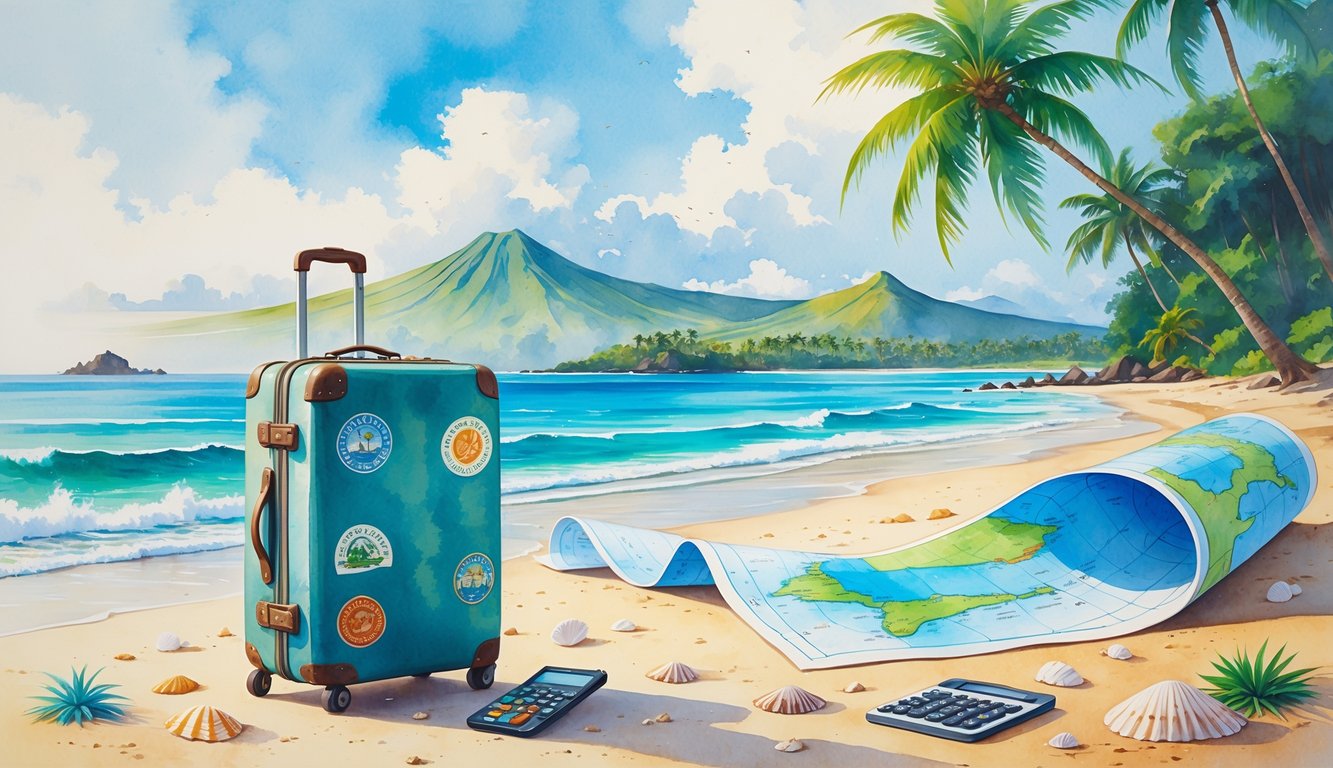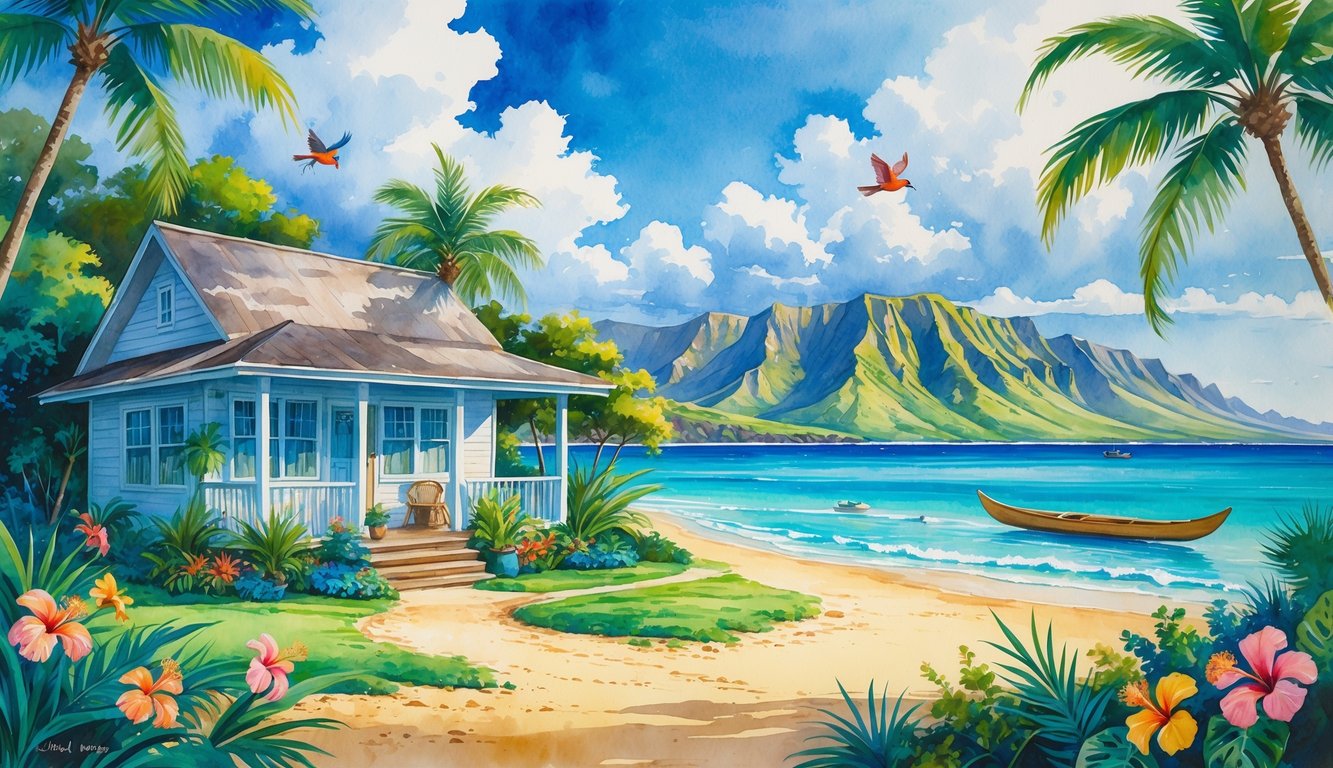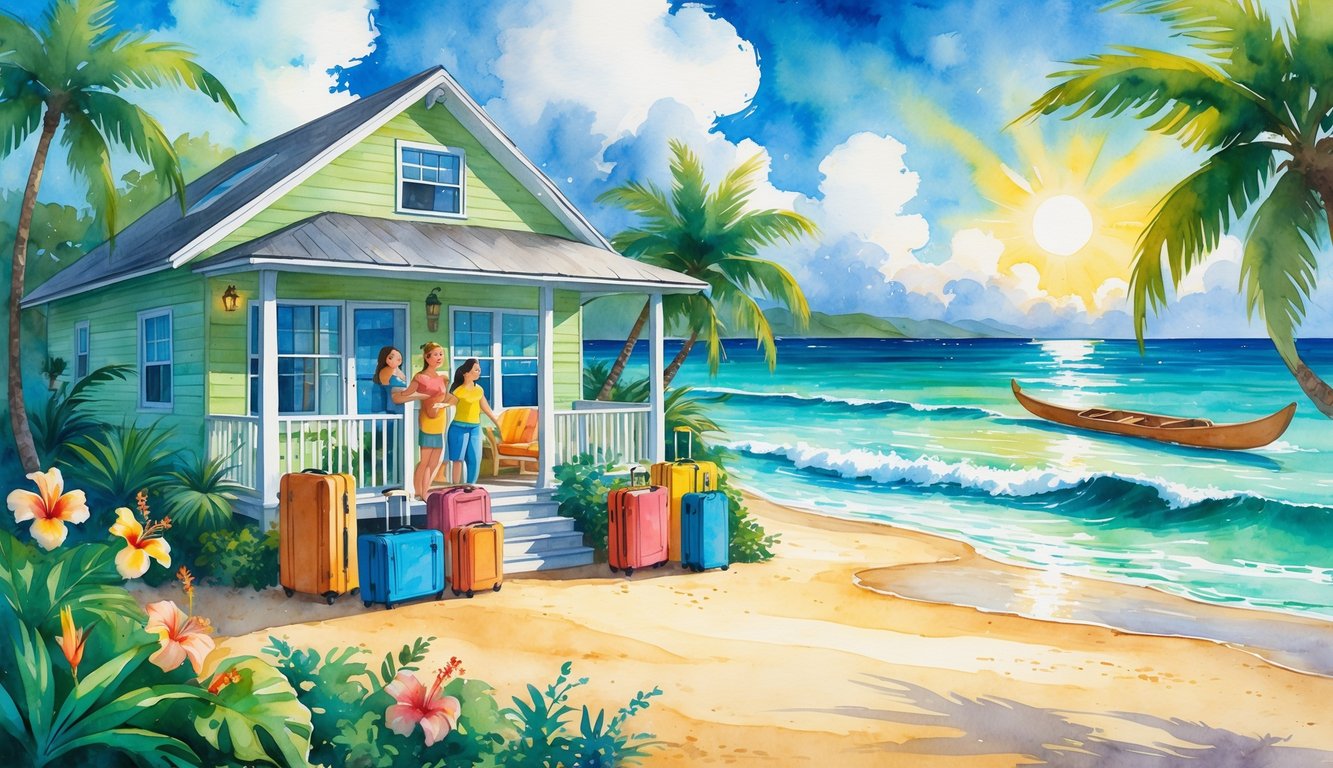Moving to Hawaii has always been a dream of mine, and I know I’m not alone. There’s something special about island life—the warm breezes, beautiful beaches, and vibrant culture attract many people.

If you want to move to Hawaii, this step-by-step guide will help you with every important detail. I’ll cover choosing the right island and making your relocation as smooth as possible.

The Hawaiian Islands offer many opportunities and unique challenges you might not face on the mainland. I’ll share what you need to know so you can avoid common headaches and enjoy your new home.
With simple steps and honest advice, you’ll feel confident about your plans to start life in paradise. For more details on moving logistics and tips, check out this moving to Hawaii guide.
Understanding Life in Hawaii
Living in Hawaii is different from the mainland United States. Local traditions, relaxed attitudes, and close connections to the land and sea shape daily life here.
Hawaiian Culture
When I moved to Hawaii, I quickly noticed that respect and family are at the heart of local life. People here follow ohana, which means family includes not just relatives but friends and neighbors too.
Greeting people with kindness and a smile is common. Elders receive respect everywhere.
Local festivals often showcase hula dancing, music, and crafts. I learned at these events that preserving history and tradition matters a lot.
The Hawaiian language, though not used all the time, appears in songs and place names. Customs might feel new at first, but joining in helps me feel at home.
Learning even a few Hawaiian words shows respect and makes daily interactions more enjoyable. For more about cultural experiences, I found this moving guide helpful.
Aloha Spirit and Island Time
The Aloha Spirit is more than just “hello” or “goodbye.” It’s about showing care and patience to anyone I meet.
Being friendly, offering help, and staying calm in conversations help me fit in here. I had to get used to island time.
Things in Hawaii move at a slower pace. Services, traffic, and business hours can be less predictable than on the mainland.
People value relationships over rushing. It took some patience, but I learned to appreciate not feeling stressed if things are delayed.
Adapting to this relaxed lifestyle helps me avoid “island fever”—that sense of being stuck. When I plan ahead, life feels smoother.
Local Cuisine and Lifestyle
Trying new foods is a big part of living in Hawaii. Popular meals include poke (seasoned raw fish), plate lunches with rice and meat, and snacks like spam musubi.
Farmers’ markets offer fresh fruit like lilikoi (passionfruit), mangoes, and papayas. I’m glad I gave everything a try because local cuisine is unique.
Shopping can be more expensive since most items come from the mainland. I learned to support local farmers and adjust my grocery list.
People here enjoy spending time outdoors, surfing, hiking, and relaxing at the beach. Community events and family gatherings are common.
The lifestyle rewards me with warm weather and beautiful scenery all year. Staying open-minded and involved helps me enjoy all the perks of living in Hawaii.
Choosing the Right Hawaiian Island

Picking where to live in Hawaii is one of the most important parts of moving. Each island has its own culture, scenery, and lifestyle, so I have to think about what really matters to me before making a decision.
Oahu
Oahu is the most populated of the Hawaiian Islands. It’s home to Honolulu, Waikiki, and Pearl Harbor.
If I want a mix of city life and sunny beaches, this may be my best choice. Honolulu has most of the state’s jobs, large hospitals, universities, and shopping centers.
Waikiki draws many tourists, so the area stays busy, but there are always fun events, restaurants, and activities. Traffic in Honolulu can be bad, so I need to plan for longer commute times if I work in the city.
Oahu also offers beautiful hiking trails and world-famous surf spots like North Shore. Cost of living is high, but neighborhoods range from lively urban centers to quieter suburbs.
Those who want convenience, nightlife, and lots of job options tend to choose Oahu.
Quick Facts Table:
| Area | Main City | Key Features | Lifestyle |
|---|---|---|---|
| Oahu | Honolulu | Waikiki Beach, Pearl Harbor | Urban, busy |
Maui
If I want a quieter, more relaxed pace but still need some modern comforts, Maui is a good fit. It’s popular for its stunning beaches, whale watching, and scenic drives on the Road to Hana.
Towns like Kihei and Lahaina offer dining and shopping in a laid-back setting. Job opportunities are not as plentiful as Oahu, but I can find options in hospitality, healthcare, and education.
Maui has a friendly, close-knit community. Outdoor lovers enjoy parks like Haleakalā National Park.
Prices for homes and groceries are high, so budgeting is important if I want to live here long term.
Maui Highlights:
- Famous beaches and surfing
- Access to volcano hikes
- Smaller crowds than Oahu
Kauai
Kauai, also called the Garden Isle, is great if I am looking for peace, nature, and slower living. The lush landscapes are perfect for hikers and anyone who loves the outdoors.
The Na Pali Coast and Waimea Canyon are famous sights. The job market is small and mostly tied to tourism, agriculture, and local services.
Almost everything closes early in the evening, so nightlife is limited. If I want to avoid crowds and enjoy privacy, moving to Kauai could be right for me.
Day-to-day life is simple and community focused, with weekend farmers’ markets and local festivals. I need to get used to limited options for shopping and dining, but the natural beauty is hard to beat.
Kauai at a Glance:
- Emerald mountains, waterfalls, and beaches
- Quiet towns and villages
- Laid-back, small-town atmosphere
Assessing the Cost of Living

The cost of living in Hawaii is higher than many parts of the mainland. I want to break down what makes up most of my monthly expenses so I know what to expect before I move.
Housing Market and Property Taxes
Housing in Hawaii is usually the biggest expense. Whether I rent or buy, the prices are much higher than what I’m used to.
For example, buying a single-family home costs much more in Oahu or Maui than in most U.S. states. Monthly rent for a one-bedroom apartment in Honolulu is often over $2,000, while larger homes cost even more.
Hawaii charges lower property tax compared to many other states, but the high cost of homes means I’ll still pay a lot overall. As of 2025, property tax rates are about 0.28%, but because homes have high values, my total annual tax bill could be significant.
If I’m thinking of buying, I should check average home prices in my preferred area on a Hawaii housing guide. Renters will want to budget extra for deposits and strict rental agreements, which are common in many neighborhoods.
Groceries and Gas Prices
Groceries in Hawaii cost more because most items come from the mainland. When I shop for milk, bread, or produce, I often pay much more.
For example, a gallon of milk may cost $6 or more. Simple produce like apples, oranges, and lettuce also have higher price tags.
Gas prices are among the highest in the U.S. Since Hawaii is far from the mainland, transporting fuel is expensive.
I might pay $5 or more per gallon, depending on the island and market changes. I could spend more on driving, especially if I live outside of city centers.
Shopping at local farmers’ markets or joining warehouse clubs like Costco may help lower some food costs. Being ready for higher grocery bills is a must.
Other Living Expenses
Utilities like electricity, water, and internet can add up quickly. Electricity is expensive because most power comes from imported oil.
Monthly electric bills in Hawaii often reach $300 or more for a family home, especially if I use air conditioning. Healthcare might cost more if my insurance plan isn’t accepted in Hawaii or if local doctors charge higher rates.
Car insurance rates can also be above average. Internet is widely available, but it may be slower or costlier on some islands.
Eating out is a treat in Hawaii but comes with a steep price. A simple meal at a casual restaurant can cost $15 to $20 per person.
If I have children, I should check private and public school options, as education and childcare costs can vary. Planning ahead and budgeting carefully can help make the move affordable.
For more breakdowns of living costs, I found this relocation breakdown informative and easy to follow.
Planning Your Move
When I decide to move to Hawaii, I know it’s important to have a clear plan. Getting organized, deciding how to move my belongings, and understanding special moving situations can make the difference between a smooth move and a stressful one.
Moving Checklist
A detailed checklist simplifies the moving process for me.
First, I set my moving date and make travel arrangements early.
I research neighborhoods to decide where I want to live.
I start searching for a job with enough income to cover Hawaii’s higher living costs.
Experts recommend earning about $70,000-$100,000 a year to live comfortably, according to Travellers Worldwide.
Next, I notify my landlord and arrange to cancel utilities, internet, and other services.
I forward my mail and update my address with banks, subscriptions, and my employer.
If I have pets, I begin Hawaii’s strict pet quarantine process early because it requires medical tests and paperwork before I arrive.
I make packing easier by going room by room and labeling boxes.
I sort my belongings and donate or sell what I don’t need.
I keep important documents in a waterproof folder to prevent loss.
Here’s a quick rundown:
| Task | When to Start |
|---|---|
| Book flights | 2-3 months out |
| Find housing | 2-3 months out |
| Notify landlord | 1-2 months out |
| Start packing | 1 month out |
| Ship car/belongings | 1 month out |
Logistics and Residential Moving
I plan carefully for shipping household goods to Hawaii.
I research reputable moving companies that handle mainland-to-island shipments.
Costs depend on distance, shipment size, and the destination island.
Many companies offer door-to-door service, managing pickup, container shipping, and delivery.
If I ship my car, I book a spot on a shipping vessel weeks in advance because spots fill up quickly.
I handle my vehicle’s registration, insurance, and safety inspection soon after arriving.
For large items, I check if selling them before moving and buying new ones in Hawaii is cheaper.
I make sure all shipments have tracking info and extra insurance.
If I plan to rent an apartment, I check lease agreements for move-in dates and arrange utility connections before I arrive.
More planning tips are available in this helpful checklist.
International and Corporate Relocations
When I move to Hawaii from another country or for work, I prepare extra paperwork.
I double-check visa requirements and work permits if coming from outside the U.S.
For corporate moves, I ask my employer about relocation packages, including help with shipping, temporary housing, and local resources.
International moving companies guide me through customs clearance, import taxes, and prohibited items.
I ask for an itemized quote and check if the company has experience with Hawaii’s regulations.
Learning about cultural differences and local customs helps before I move.
If my company manages the move, I coordinate with their relocation team to match my timeline and work needs.
For more advice, I use specialized guides on international and corporate moves to Hawaii.
Transporting Household Goods and Vehicles
When I planned my move to Hawaii, I realized transporting household goods and vehicles involves a few key steps.
Careful planning helps, whether I arrange storage, ship a car, or protect fragile items.
Warehousing and Storage Options
Few mainland moving companies offer temporary or long-term warehousing before shipping goods to Hawaii.
If my new home isn’t ready, I store my belongings in a secure local facility.
This gives me flexibility to move in stages or handle delays.
Climate-controlled storage protects electronics, wooden furniture, and documents from Hawaii’s humidity.
Some moving companies provide inventory management and distribution, helping me track items and schedule delivery.
For goods already in Hawaii, inter-island storage and freight options exist.
Companies like Young Brothers move items between major islands, making resettling easier if I change islands later.
Vehicle Transport and Trucking
Shipping a car or truck from the mainland to Hawaii usually involves specialized carriers like Matson, Pasha Hawaii, or Horizon Lines.
Most vehicles travel by sea, and I drop off my vehicle at a designated West Coast port, like Long Beach or Seattle.
Costs range from about $1,400 to $2,400 per vehicle, depending on the carrier and starting location.
Some movers bundle household and vehicle shipping, handling drayage from my home to the port and final delivery in Hawaii.
This streamlines the process and saves me time.
Trucking and local drayage services haul my containers from the port to my new house.
Special Crating and Freight Services
Items like pianos, antiques, or artwork need extra protection when moving across the ocean.
I request special crating; wooden crates are custom-built to fit and protect valuable things from shifting or humidity.
Industrial freight services handle oversized goods or business equipment using strong packing materials and heavy-duty pallets.
Some movers install large appliances or equipment once they arrive, so I don’t have to set them up myself.
Extra care at this stage protects my most important items and ensures everything arrives in usable condition.
For more details, see how to ship belongings and vehicles to Hawaii.
Settling In After Arrival
When I arrived in Hawaii, I quickly took care of several important tasks.
Updating my documents and getting a local ID made my move smoother.
Change of Address and Legal Documents
One of my first steps was submitting a change of address with the United States Postal Service.
This ensured my mail reached my new home.
I updated my address with my bank, credit card companies, and health insurance.
I changed my address on my voter registration and car insurance to avoid problems.
I notified utilities like electric, water, and internet of my new address.
Updating official records as soon as possible is important.
A checklist helped me remember these steps.
I tried to complete everything within my first week to avoid mail delays or service issues.
Getting a Hawaii Driver’s License
If I planned to drive in Hawaii, I needed to get a Hawaii driver’s license.
New residents have about 30 days to switch from an out-of-state license.
I gathered my old license, proof of legal presence (like a passport), my Social Security card, and proof of my Hawaii address.
I made an appointment at the local DMV, filled out the application, and paid the fee.
Sometimes, new residents take a written or vision test.
The process can vary by island, but most locations are listed on county websites.
After finishing everything, I got my new license and felt more settled as a local driver.
For more tips, I used Hawaii Guide’s moving checklist.
Navigating the Job Market
When I thought about moving to Hawaii, I worried about finding a job.
Hawaii’s job market is different from many mainland places, so I learned what to expect before the move.
Tourism, healthcare, education, and government are key industries in Hawaii.
Jobs in hotels, restaurants, and visitor experiences are always needed, but competition can be high.
Healthcare and education jobs are common, especially for those with experience.
Here are some steps I took to get ready:
- I researched jobs online before moving.
- I used sites like State of Hawai’i Careers, Indeed, and county job boards.
- I checked if my career field was in demand in Hawaii.
- I updated my resume and prepared for video interviews.
Here’s a quick look at major job sectors:
| Industry | Common Jobs |
|---|---|
| Tourism | Hotel staff, tour guides |
| Healthcare | Nurses, medical assistants |
| Education | Teachers, aides |
| Government | Administrative, services |
| Retail | Sales clerks, managers |
Because living costs are higher, I planned my budget and targeted jobs that can support my needs.
You can learn more about planning your move and researching Hawaiian jobs online.
Adjusting to Island Life

Moving to Hawaii means adjusting to new routines, a different social atmosphere, and unfamiliar daily habits.
Settling in is more than unpacking—it’s about learning how people connect and support each other across the islands.
Culture Shock and Community
When I arrived, I noticed daily life moves at a slower pace than on the mainland.
Locals value patience, respect, and kindness.
People greet each other with “aloha,” which means warmth and caring in every interaction.
I adjusted to the strong sense of community.
Neighbors look out for each other, and joining events or volunteering helps me feel included.
Sharing food at gatherings or joining traditional celebrations like a luau is a big part of fitting in.
If I bring an open mind and show respect for local customs, making friends becomes easier.
The laid-back attitude and community focus make daily life calmer, though it can be an adjustment if I’m used to city living.
Senior Relocations and Support
Relocating as a senior brings unique concerns.
I looked for healthcare options, support groups, and places with easy access to shops and services.
Many seniors move to the islands for the mild weather and relaxed lifestyle, but housing and healthcare are more expensive than in most states.
I found that senior centers offer classes, meals, and social activities that help newcomers make friends.
Some neighborhoods have programs connecting seniors to volunteers for errands or help around the house.
Family is important in Hawaiian culture, and many people look out for their kupuna (elders).
Connecting with local resources for seniors makes the move smoother and helps me feel included.
Exploring Your New Home

Hawaii offers much more than beaches and sunshine.
Each area has its own character, with plenty to discover whether I enjoy hiking rugged trails or relaxing in small towns.
Outdoor Adventures and Landmarks
When I first explored Hawaii, I found it easy to enjoy the outdoors.
One of my favorite places is Hawaii Volcanoes National Park. Here, I see active volcanoes, hike through lava tubes, and watch steam vents up close.
It’s exciting and educational.
Waikiki offers lively beaches and surf spots. The area combines shopping, restaurants, and ocean views.
It’s perfect when I want more activity or want to learn to surf.
If I want breathtaking scenery, I visit the Na Pali Coast on Kauai. The cliffs and hiking trails, like the Kalalau Trail, let me see waterfalls and hidden beaches.
I can also take boat tours or helicopter rides to view the coastline.
Moving to Hilo and Kailua-Kona
On the Big Island, Hilo and Kailua-Kona attract many newcomers like me.
Hilo offers lush rainforests, waterfalls, and a slower pace.
I enjoy walking through the local farmers markets and exploring places like Liliuokalani Gardens.
Kailua-Kona feels drier and sunnier.
This area features coffee farms, clear waters for snorkeling, and historic sites.
When I moved here, I found shops and restaurants easy to access.
The international airport also makes travel simple.
Hilo gives me peace and a strong community feel.
Kailua-Kona provides more tourism and modern conveniences.




